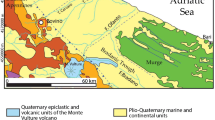Abstract
The Kahroud region located in the Alborz Mountains, northern Iran is subject to landslide. In this paper, the impact of two different Persistent Scatterer Interferometry methods on the study area is examined. The standard Stanford method for Persistent Scatterer (StaMPS) was applied to 14 ENVISAT ASAR images spanning between 2006 and 2008, but it was found that the displacement was underestimated due to a high deformation rate. A hybrid method that is a combination of conventional and PSI methods was then applied to the study area. In this method, the deformation rate roughly estimated by stacking the coherent interferograms characterized by small baselines was estimated and subtracted from the wrapped phase. The residual phase was then unwrapped using the standard StaMPS. The estimated rate was finally added back to the unwrapped residual phase. The maximum Line-Of-Sight (LOS) deformation rate estimated from the hybrid method was 25 mm/year, belonging to an area located in the lower part of the landslide. The deformation time series of a couple of distinct points showed differing behavior in different time periods. However, the area was still found to be generally sliding toward the satellite. These results were validated with GPS measurements at 7 stations. The Root Mean Square Error (RMSE) between LOS GPS-derived rates and rates estimated from the hybrid method was estimated as 4 mm/year.














Similar content being viewed by others
References
Chatterjee, R. S., Fruneau, B., Rudnat, J. P., Rpy, P. S., Frison, P. L., Lakhera, R. C., Dadhwal, V. K., & Saha, R. (2006). Subsidence of Kolkata (Calcutta) City, India during the 1990s as observed from space by Differential Synthetic Aperture Radar Interferometry (D-InSAR) technique. Remote Sensing of Environment, 102, 176–185.
Chen, C. W., & Zebker, H. A. (2001). Two-dimensional phase unwrapping with use of statistical models for cost functions in nonlinear optimization. Journal of the Optical Society of America A, 18(2), 338–351.
Cornforth, D. H. (2005). Landslides in practice: investigation, analysis and remedial/preventative options in soils. New York: Wiley.
Crosetto, M., Tscherning, C. C., Crippa, B., & Castillo, M. (2002). Subsidence monitoring using SAR interferometry: reduction of the atmospheric effects using stochastic filtering. Geophysical Research Letters, 29(9), 26.1–26.4.
Cruden, D. M. (1991). A simple definition of a landslide. Bulletin of Engineering Geology and the Environment, 43(1), 27–29.
Dehghani, M., Valadan Zoej, M. J., Hooper, A., Hanssen, R. F., Entezam, I., & Saatchi, S. (2013). Hybrid conventional and Persistent Scatterer SAR interferometry for land subsidence monitoring in the Tehran Basin, Iran. ISPRS Journal of Photogrammetry and Remote Sensing, 79, 157–170.
Efron, B., & Tibshirani, R. (1986). Bootstrap methods for standard errors, confidence intervals, and other measures of statistical accuracy. Statistical Science, 1(1), 54–75.
Ferretti, A., Prati, C., & Rocca, F. (2000). Nonlinear subsidence rate estimation using Permanent Scatterers in Differential SAR Interferometry. IEEE Transactions on Geoscience and Remote Sensing, 38(5), 2202–2212.
Ferretti, A., Prati, C., & Rocca, F. (2001). Permanent scatterers in SAR interferometry. IEEE Transactions on Geoscience and Remote Sensing, 39(1), 8–20.
Fruneau, B., & Sarti, F. (2000). Detection of ground subsidence in the city of Paris using radar interferometry: isolation from atmospheric artifacts using correlation. Geophysical Research Letters, 27(24), 3981–3984.
Galloway, D. L., & Hoffmann, J. (2007). The application of satellite differential SAR interferometry-derived ground displacements in hydrogeology. Hydrogeology Journal, 15(1), 133–154.
Hooper, A. (2010). A Statistical-cost approach to unwrapping the phase of InSAR time series. Proc. Fringe 2009 Workshop.
Hooper, A., Zebker, H., Segall, P., & Kampes, B. (2004). A new method for measuring deformation on volcanoes and other natural terrains using InSAR persistent scatterers. Geophysical Research Letters, 31, 611–615.
Hooper, A., Segall, P., & Zebker, A. (2007). Persistent scatterer interferometric synthetic aperture radar for crustal deformation analysis, with application to Volcan Alcedo, Galapagos. Journal of Geophysical Research, 112(B07407), 1–21.
Indirli, M., Nigro E., Kouris, L., Romanelli, F., & Zuccaro, G. (2010). Mitigation options for natural hazards, with a special focus on volcanic eruptions. Proceedings of the COST C26 Action Final Conference. Taylor & Francis group.
Kampes, B. M. (2005). Displacements Parameter Estimation using Permanent Scatterer Interferometry, DLR, Bibliotheks- und Informationswesen, Stuttgart.
Ketelaar, G. (2009). Satellite radar interferometry subsidence monitoring techniques. the Netherlands: Springer.
Lanari, R., Lundgren, P., Manzo, M., & Casu, F. (2004). Satellite radar interferometry time series analysis of surface deformation for Los Angeles, California. Geophysical Research Letters, 31, 1–5.
Peltzer, G., Rosen, P., Rogez, F., & Hudnut, K. (1998). Poro-elastic rebound along the Landers 1992 earthquake surface rupture. Journal of Geophysical Research, 103(B12), 30131–30145.
Peyret, M., Djamour, Y., Rizza, M., Ritz, J.-F., Hurtrez, J.-E., Goudarzi, M. A., Nankali, H., Chéry, J., Le Dortz, K., & Uri, F. (2008). Monitoring of the large slow Kahrod landslide in Alborz mountain range (Iran) by GPS and SAR interferometry. Engineering Geology, 100, 131–141.
Rott, H., Nagler, T., Rocca, F., Prati, C., Mazzotti, A., Keusen, H., Liener, S., & Tarchi, D. (2003). Geoinformation for European-wide integration: InSAR techniques and applications for monitoring landslides and subsidence (pp. 25–31). MillPress, Rotterdam
Singh, L. P., (2003). Application of SAR interferometry in landslide studies with special reference to generation of input data for statistical susceptibility assessment. MSc. degree thesis submitted to the international for geo-information science and earth observation.
Tesauro, M., Beradino, P., Lanari, R., Sansoti, E., Fornaro, G., & Franceschetti, G. (2000). Urban subsidence inside the City of Napoli (Italy) observed with synthetic aperture radar interferometry at Campi Flegrei caldera. Journal of Geophysical Research, 27, 1961–1964.
Acknowledgments
We wish to thank the European Space Agency (ESA) for providing ENVISAT ASAR data. We convey our sincere gratitude to Prof. Andrew Hooper for providing StaMPS software and helpful discussions.
Author information
Authors and Affiliations
Corresponding author
About this article
Cite this article
Dehghani, M. Landslide Monitoring Using Hybrid Conventional and Persistent Scatterer Interferometry. J Indian Soc Remote Sens 44, 505–513 (2016). https://doi.org/10.1007/s12524-015-0536-3
Received:
Accepted:
Published:
Issue Date:
DOI: https://doi.org/10.1007/s12524-015-0536-3




